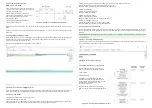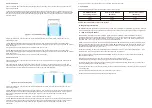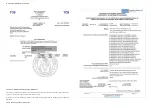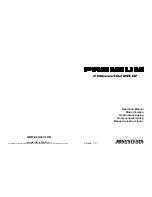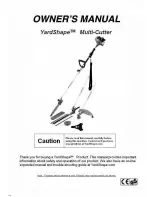
9.2.2 Scan window
The scan window has to be selected such that the receiver will under all conditions receive at least one full
advertising telegram.
To ensure this requirement, we consider the worst-case condition where the receiver starts scanning directly
after the start of one transmission and therefore misses a part of it. Under these conditions, it is necessary that
the receiver remains active until the next advertising telegram has been fully transmitted. This is illustrated in
Figure 41 below.
Figure 41 – Scan window setting
From Figure 41 above it can be seen that the minimum duration of the scan window is dependent on the
advertising interval:
1.If SR-SBP2801-BLE-E uses 20 ms advertising intervals, then the scan window has to be at least 20 ms
(advertising interval) plus 0.5 ms (telegram duration) plus a timing margin to account for the random time offset
at the transmitter.
Using a scan window of at least 23 ms is recommended for this case.
2.If SR-SBP2801-BLE-E uses 10 ms advertising intervals, then the scan window has to be at least 10 ms
(advertising interval) plus 0.5 ms (telegram duration) plus a timing margin to account for the random time offset
at the transmitter.
Using a scan window of at least 13 ms is recommended for this case.
9.2.3 Scan interval
The scan interval has to be selected such that the receiver will not be inactive so long that it misses all three
advertising events.
The longest period for which the receiver can be inactive is given by the time between the end of the first
advertising events (assuming that the receiver exactly misses the last bit of it) and the beginning of the third
advertising event (so that this will certainly be received). Figure 42 illustrates this.
Figure 42 – Scan interval setting
From Figure 42 above it can be seen that the maximum duration of the scan interval is de- pendent on the
advertising interval:
1.If SR-SBP2801-BLE-E uses 20 ms advertising intervals, then the scan interval has to be less than the time
between the end of the first advertising event and the begin of the third advertising event (2 * 20 ms = 40 ms)
minus 0.5 ms (telegram duration) minus a timing margin to account for the random time offset at the
transmitter.
Using a scan interval of no more than 37 ms is recommended for this case.
2.If SR-SBP2801-BLE-E uses 10 ms advertising intervals, then the scan interval has to be less than the time
between the end of the first advertising event and the begin of the third advertising event (2 * 10 ms = 20 ms)
minus 0.5 ms (telegram duration) minus a timing margin to account for the random time offset at the
transmitter.
Using a scan interval of no more than 17 ms is recommended for this case.
9.2.4 Summary
Table 9 below summarizes the recommended receiver scan settings.
SR-SBP2801-BLE-E
Advertising Interval
10 ms
20 ms
Receiver Scan Window
(Minimum)
23 ms
13 ms
Receiver Scan Interval
(Maximum)
37 ms
17 ms
Table 9 – Recommended receiver scan settings
10.Regulatory information
SR-SBP2801-BLE-E has been certified according to FCC (US), ISED (CA) and RED (EU) regulations. Changes
or modifications not expressly approved by Sunricher could void the user's authority to operate the equipment.
10.1 RED for European Market
The Radio Equipment Directive (2014/53/EU, typically referred to as RED) replaces R&TTE directive as
regulatory framework for radio products in the European Union. All products sold final customers within the
European Union have to be compliant to RED. At the time of writing, the text of the RED legislation was
available from this link: http://eur- lex.europa.eu/eli/dir/2014/53/oj
Dolphin radio modules are components which are delivered to OEM manufacturers for their use/integration in
final or combined products. It is the responsibility of the OEM manufacturer to demonstrate compliance to all
applicable EU directives and standards. The Sunricher attestation of conformity can be used as input to the
declaration of conformity for the full product.
At the time of writing, guidance on the implementation of EU product rules – the so called “Blue Guide” – was
available from this link: http://ec.europa.eu/DocsRoom/documents/18027/
Specifically within the new RED framework, all OEM manufacturers have for instance to fulfill the following
additional requirements:
•Provide product branding (on the product) clearly identifying company name or
brand and product name as well as type, charge or serial number for market surveillance
•Include (with the product) documentation containing full postal address of the manufacturer as well as radio
frequency band and max. transmitting power
•Include (with the product) user manual, safety information and a declaration of conformity for the final product
in local language
•Provide product development and test documentation upon request
Please contact an accredited test house for detailed guidance.









